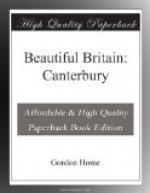To touch even lightly on the subsequent history of Canterbury is not possible here, but its remarkably interesting story has been woven into a connected narrative by Dr. Cox, whose admirable book should be procured by all who may, by reading this little sketch, feel some of the glamour which the old city has for the writer.
CHAPTER III
THE CATHEDRAL
From the swelling green hills that look over Canterbury the distant glimpses of the Cathedral towers gleaming in that opalescent light that is the joy of a summer’s morning in Kent, are so hauntingly beautiful that it is hard to believe that no disillusionment need be anticipated when the ancient city is entered and the great church seen at close quarters in the midst of a little city whose busy streets are agog with twentieth-century interests; and yet apprehension is entirely needless. From St. Dunstan’s Church, where Henry II. stripped himself to a shirt and cloak on entering as a penitent, the road is lined with houses whose quietly picturesque frontages improve as the city proper is neared, and at the end of a most pleasing perspective stands the West Gate, a great stone gateway with round towers. Passing through the archway, one is at once in the narrow, jostling familiarity of the medieval St. Peter’s Street. This crosses one at the arms of the Stour, and continues as High Street, becoming increasingly rich in overhanging storeys and curious sixteenth and seventeenth century fronts. One’s eye glances rapidly from side to side, until, on the left, an exceedingly narrow turning gives a peep—such a peep as no other city can give unless it be Rouen—of the Cathedral’s western towers rising above a sumptuously enriched stone gateway framed by tall, timbered houses, which nod towards one another in the neighbourly fashion of old cronies. It might be that the modern pilgrim, whose course is thus arrested by the vision he sees in this cleft called Mercery Lane, might have had some intention of going straight through the city to St. Martin’s Church outside the walls to the east; but, if so, he is a strong man who resists the appeal of that narrow way belonging altogether to the world of romance. He stands for a moment transfixed, and then plunges into the opening, forgetful of his original purpose in the vivid reality before him. He walks down the lane trodden century after century by countless pilgrims and enters the Cathedral precincts through the weather-worn gateway, Prior Goldstone II. built between 1507 and 1517.
From the archway the first near vision of the vast pile is unfolded, nearly the whole of the south side being visible. Immediately opposite are the two western towers, the nearer one finished in 1451 and the further rebuilt seventy years ago. The heavily buttressed nave, in the same Perpendicular style, stretches away to the transept, where the eye mounts up higher and higher until it rests on the clustered




